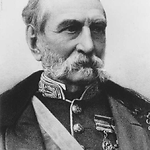Person
Clarke, Andrew (1824 - 1902)
RE MLC FRSLVD HonMInstCE

Clarke, Andrew Portrait
Details
- Born
- 27 July 1824
Southsea, Hampshire, England - Died
- 29 March 1902
London, England - Occupation
- Member of Parliament, Science patron, Surveyor and Politician
Summary
Sir Andrew Clarke was Surveyor-General of the Colony of Victoria and was a member of both Victoria's Legislative Council and Assembly. He was also heavily involved in many societies and organisations including holding office as inaugural President of both the Philosophical Society of Victoria (1854), and the Philosophical Institute of Victoria (1855-1857). As a member of the Legislative Council, Clarke was involved in drafting the colony's new Constitution and the Municipal Institutions Act. He also instigated the creation of the Museum of Natural History, selected the sites of the Botanic Gardens and St Paul's Anglican Cathedral, instigated the recording of meteorological data, and set about establishing a pure water supply for Melbourne. Clarke returned to the United Kingdom in c.1859 but continued to work on special commissions for the Victorian and Tasmanian governments and served as their Agent-General for varying periods. Up to 1886 Clarke had a distinguished career in the colonial service and for the British army.
Details
Chronology
- 1844
- Education - Graduated from the Royal Military Academy, UK
- 1844 - 1886
- Career position - Member of the Royal Engineers, UK
- 26 Jan 1847 - 26 Jan 1848
- Life event - Posted to Australia (Hobart Town)
- 1848 - 1849
- Career position - Posted to New Zealand
- 1849 - 1853
- Career position - Returned to Hobart as Private Secretary to the Lieutenant-Governor
- 1853 - 1856
- Career position - Official Member of the Legislative Council of Victoria
- 1853 - 1858
- Career position - Surveyor-General of the Colony of Victoria
- 1854 - 1855
- Career position - President, Philosophical Society of Victoria
- 1854 - 1855
- Career position - Vice-President of the Victorian Institute for the Advancement of Science
- 1855 - 1857
- Career position - President, Philosophical Institute of Victoria
- 1856 - 1858
- Career position - Elected to the Legislative Assembly of Victoria
- 1858 -
- Life event - Returned to England
- 1858
- Career position - Member, Board of Science, Colony of Victoria
- 1858 - 1859
- Award - Honorary Member, Philosophical Institute of Victoria
- 1859 - 1902
- Award - Honorary Member, Royal Society of Victoria
- 4 Apr 1865
- Career event - Associate (AssocInstCE), Institution of Civil Engineers, London
- 1869
- Award - Companion of the Order of the Bath (CB)
- 1873
- Award - Commander of the Order of St Michael and St George (KCMG)
- 1885
- Award - Knight Grand Cross of the Order of St Michael and St George (GCMG)
- 1 Dec 1896
- Award - Honorary Member (Hon MInstCE), Institution of Civil Engineers, London
Related entries
Published resources
Books
- Clarke, Andrew: edited by R. H. Veitch, Life of Lieut.-General the Hon. Sir Andrew Clarke, G.C.M.G., C.B., C.I.E., Colonel-Commandant of Royal Engineers, Agent-General of Victoria, Australia (London: John Murray, 1905), 353 pp. Details
- Cumming, D. A., Some Public Works Engineers in Victoria in the Nineteenth Century (Melbourne: University of Melbourne, Department of Mechanical and Industrial Engineering, 1985), 59 pp. pp.6-7. Details
Book Sections
- Malone, Betty, 'Clarke, Sir Andrew (1824-1902)' in Australian dictionary of biography, volume 3: 1851 - 1890 A-C, Douglas Pike, ed. (Melbourne: Melbourne University Press, 1969), pp. 409-411. http://www.adb.online.anu.edu.au/biogs/A030386b.htm. Details
Resources
- Wikidata, http://www.wikidata.org/entity/Q4756615. Details
- VIAF - Virtual International Authority File, OCLC, https://viaf.org/viaf/4040987. Details
- Institution of Civil Engineers, London, 'Application: 9506, 1896 [HonMInstCE]', Civil Engineer Membership Forms, 1818-1930, ancestry.com, https://www.ancestry.com.au/search/collections/3585/. Details
- Institution of Civil Engineers, London, 'Application: 1940, 1865 [AssocInstCE]', Civil Engineer Membership Forms, 1818-1930, ancestry.com, https://www.ancestry.com.au/search/collections/3585/. Details
- 'Clarke, Andrew (18240727-19020329)', Trove, National Library of Australia, 2009, https://nla.gov.au/nla.party-1476021. Details
See also
- 'Board of Science [Establishment and initial Board members]', Victorian Government Gazette (1858), 1065, https://gazette.slv.vic.gov.au/view.cgi?year=1858&class=general&page_num=1065. Details
- Federation and Meteorology, 2001, http://www.austehc.unimelb.edu.au/fam/index_c.html. Details
- Science and the making of Victoria, with Royal Society of Victoria, 2001, http://www.austehc.unimelb.edu.au/smv/index_c.html. Details
- Harper, Brian C. S., Engineering challenges in nineteenth century Victoria (Port Melbourne: the author, 2016), 256 pp. pp.4-7, 10-11, 16-7, 25-6, 143-7, 165, 168-9, 173, 206-7, 225. Details
- Serle, Percival, Dictionary of Australian biography (Sydney: Angus & Robertson, 1949). Details
- Thomson, Kathleen and Serle, Geoffrey, A biographical register of the Victorian parliament 1859 - 1900 (Canberra: Australian National University Press, 1972), 238 pp. https://openresearch-repository.anu.edu.au/bitstream/1885/114931/2/b14277530.pdf. Details
Digital resources
Helen Morgan and Helen Cohn
Created: 24 August 2000, Last modified: 27 March 2025
- Foundation Supporter - Royal Society of Victoria
